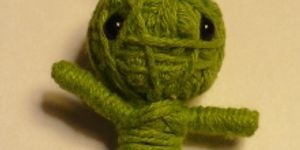Health & Medicine
Have a Snack and Keep the Peace
APR 17, 2014 12:00 AM PDT
Share
The Potential Role of Silly Putty in Stem-Cell Research
 We all had Silly Putty as children, the wonderful toy that we used for everything from bouncy balls to pencil holders to a way to lift comics off of the newspaper page. Others have discovered practical uses of Silly Putty, such as zero gravity adhesive - astronauts in the 1960's used it to hold their tools in place.
We all had Silly Putty as children, the wonderful toy that we used for everything from bouncy balls to pencil holders to a way to lift comics off of the newspaper page. Others have discovered practical uses of Silly Putty, such as zero gravity adhesive - astronauts in the 1960's used it to hold their tools in place. However, the primary component of Silly Putty has a new use in stem cell technology. Silly Putty is composed mostly of polydimethylsiloxane (PDMS), which has visco-elastic and sponge-like behavior that gives Silly Putty its unusual range of properties. A research group at the University of Michigan used the variable properties of PDMS to guide the growth of stem cells into different types of functional cells. Their work was published in a recent online edition of Nature Materials.
Very fine threads of PDMS were created as a support system for the starting stem cells, in the form of posts. The rigidity of the PDMS varied with the height of the formed posts, graduating from stiffer short posts in to softer tall posts.
The taller posts allowed for transformation of stem cells into nerve cells in a higher population and at a faster rate when compared to the more rigid shorter posts. By the 23-day mark, the taller, softer posts had produced more spinal cord cells by a factor of ten over the rigid posts, and at four times the purity.
The significance of this work is that it is the first to display a connection between the differentiation process of human embryonic stem cells and their surrounding physical signals. This work can not only provide greater insight into how these cells eventually transform into different body components such as nerves, muscles, or organs, but also into better methods of developing treatments based on cell replacement - especially if the method can work on adult stem-cells as well as embryonic ones.
For example, consider the disease Amyotrophic Lateral Sclerosis, otherwise known as ALS or Lou Gehrig's disease. ALS destroys neurons in the spinal cords and brains of their victims, eventually killing them through paralysis. Imagine a method in which high-purity replacement neurons could be efficiently grown, starting from the patient's own cells.
The team has already shown that the neurons that were created on the softer posts had similar electrical activity to that of neurons within the human body. Theoretically, a series of different cell growth surfaces could be micro-engineered to mimic the physical signals of specific locations within the human body - directing high-purity growth of a particular type of replacement cell.
It remains to be seen if the same success will be obtained with adult stem cells. If embryonic stem cells are necessary, another layer of difficulty will be added just from the political and religious issues associated with using embryonic stem cells-not to mention the supply.
Even so, we expect the follow-up to this research to yield even more exciting breakthroughs in cell therapies and treatments in the coming years - whether or not Silly Putty is involved.
You May Also Like
Loading Comments...








